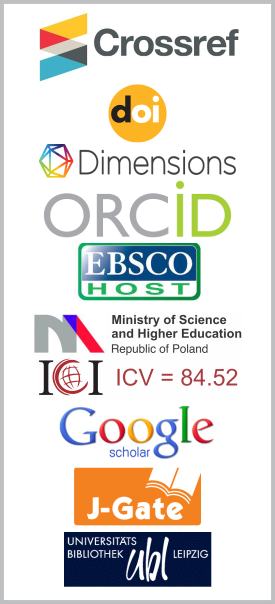The Prospect of Micro-Energy Generation from Almond (Prunus Dulcis) Dye-Sensitized Solar Cells
DOI:
https://doi.org/10.26713/jims.v9i2.724Keywords:
Micro-energy generation, Dye-sensitized solar cell, Spectral responses, Almond, Sustainable energyAbstract
The generation of environmentally and sustainable energy is a basic need towards proffering a solution to the climatic and scientific challenges confronting twenty-first century human race. This quest has led to the discovery of diverse unconventional energy resources existing presently. Amongst all these viable options, solar energy is considered to have the best prospect in view of its all-year availability, no geographical restriction and theDownloads
References
S.A.M. Al-Bathi, I. Alaei and I. Sopyan, Natural photosensitizers for dye sensitized solar cells, International Journal of Renewable Energy Research 3 (1) (2013), 138–143.
G. Boschloo and A. Hagfeldt, Characteristics of the iodide/triiodide redox mediator in dye-sensitized solar cells, Accounts of Chemical Research 42 (11) (2009), 1819–1826.
M. Grätzel, Recent advances in sensitized mesoscopic solar cells, Accounts of Chemical Research 42 (11) (2009), 1788–1798.
S. Hwang, J.H. Lee, C. Park, H. Lee, C. Kim, C. Park, M.H. Lee, W. Lee, J. Park, K. Kim, N.G. Park and C. Kim, A highly efficient organic sensitizer for dye-sensitized solar cells, Chemical Communications 46 (2007), 4887–4889.
N.C. Jeong et al., Effective panchromatic sensitization of electrochemical solar cells: strategy and organizational rules for spatial separation of complementary light harvesters on high-area photo electrodes, J. Am. Chem. Soc. 134 (2012), 19820–19827.
D. Kuang et al., Co-sensitization of organic dyes for efficient ionic liquid electrolyte-based dyesensitized solar cells, Langmuir 23 (2007), 10906–10909.
S.M. Milenkovic, J.B. Zvezdanovic, T.D. Andjelkovic and D.Z. Markovic, The identification of chlorophyll and its derivatives in the pigment mixtures: HPLC-chromatography, visible and mass spectroscopy studies, Adv. Tech. 1 (1) (2012), 16–24.
M.K. Nazeeruddin, A. Kay, I. Rodicio, R. Humpbry-Baker, E. Miiller, P. Liska, N. Vlachopoulos and M. Grätzel, Conversion of light to electricity by cis-X2bis(2,2'-bipyridyl-4,4'-dicarboxylate) ruthenium(II) charge-transfer sensitizers (X = Cl=, Br-, I=, CN=, and SCN=) on nanocrystalline titanium dioxide electrodes, J. Am. Chem. Soc. 115 (1993), 6382–6390.
M.K. Nazeeruddin, P. Péchy, T. Renouard, S.M. Zakeeruddin, R. Humphry-Baker, P. Comte, P. Liska, L. Cevey, E. Costa, V. Shklover, L. Spiccia, G.B. Deacon, C.A. Bignozzi and M. Grätzel, Engineering of efficient panchromatic sensitizers for nanocrystalline TiO2-based solar cells, Journal of the American Chemical Society 123 (8) (2001), 1613–1624.
B.C. O'Regan and F. Lenzmann, Charge transport and recombination in a nanoscale interpenetrating network of n-type semiconductors: transient photocurrent and photovoltage studies of TiO2/dye/CuSCN photovoltaic cells, J. Phys. Chem. B 108 (2004), 4342–4350.
S. Sharma, S. Bulkesh, S.K. Ghoshal and D. Mohan, Dye sensitized solar cells: From genesis to recent drifts, Renewable and Sustainable Energy Reviews 70 (2017), 529–537.
S. Tontapha, W. Sangaroon, S. Kanokmedhakul, T. Promgool and V. Amornkitbamrung, Effects of dye-adsorption solvents, acidification and dye combination on efficiency of DSSCs sensitized by (alpha)-mangostin and anthocyanin from mangosteen pericarp, J. Mater. Sci.: Mater Electron (2017).
V. Varadharajan, U.K. Janarthanan and V. Krishnamurthy, Physicochemical, phytochemical screening and Profiling of secondary metabolites of Annona Squamosa leaf extract, J. Pharmacogn and Phytochem. 5 (2) (2016), 200–203.
J.H. Yum, E. Baranoff, S. Wenger, M.K. Nazeeruddin and M. Gratzel, Panchromatic engineering for dye-sensitized solar cells, Energy Environ. Sci. 4 (2011), 842–857.
Q. Zhang and G. Cao, Nanostructured photoelectrodes for dye-sensitized solar cells, Nano Today 6 (1) (2011), 91–109.
Downloads
Published
How to Cite
Issue
Section
License
Authors who publish with this journal agree to the following terms:- Authors retain copyright and grant the journal right of first publication with the work simultaneously licensed under a CCAL that allows others to share the work with an acknowledgement of the work's authorship and initial publication in this journal.
- Authors are able to enter into separate, additional contractual arrangements for the non-exclusive distribution of the journal's published version of the work (e.g., post it to an institutional repository or publish it in a book), with an acknowledgement of its initial publication in this journal.
- Authors are permitted and encouraged to post their work online (e.g., in institutional repositories or on their website) prior to and during the submission process, as it can lead to productive exchanges, as well as earlier and greater citation of published work.




